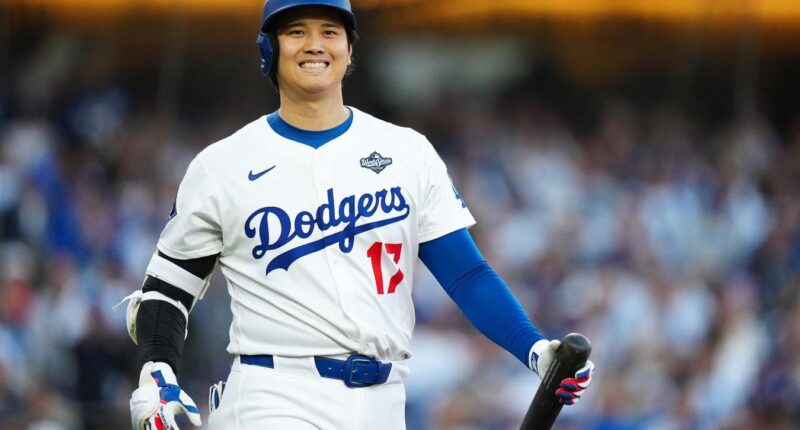Share this @internewscast.com
In an unprecedented development, Major League Baseball (MLB) has achieved record-breaking sponsorship revenues for 2025, surpassing the $2 billion mark for the first time. This milestone has been significantly driven by the efforts of the Los Angeles Dodgers.
As highlighted in the 2025 MLB Marketing Partnerships report published by SponsorUnited, the total team sponsorship revenue surged to $2.05 billion. This represents a 9% increase from the previous year, 2024, and a substantial 68% rise since 2022. MLB now stands as only the second sports league in North America to cross the $2 billion barrier in team sponsorship revenue, joining the ranks of the NFL, which achieved this feat back in 2022.
To compile these impressive figures, SponsorUnited conducted an extensive analysis, evaluating 422,000 rights holders and brands, 2.5 million deals, and 21.1 million data points from various domains, including sports, entertainment, media, and talent.
One of the primary catalysts for this financial success has been the proliferation of premium jersey patch (PJP) sponsorship deals across the league. These agreements now contribute an average of $17 million annually. In 2025, new PJP partnerships were secured by teams such as the Washington Nationals with AARP, the Minnesota Twins with Securian Financial, the Colorado Rockies with York Space Systems, the Seattle Mariners with Nintendo, and the Athletics with Las Vegas Tourism. Remarkably, by 2025, 28 out of the 30 MLB clubs had secured PJP deals, a significant increase from the 53% of teams that had such agreements in 2023.
Patch Deals Now Reach All But Two Clubs
Regarding industry participation in club sponsorships, Financial Services led with $284 million in deals for 2025, making up 14% of the total revenue. Following this were Alcoholic Beverages ($167 million), Insurance ($164 million), Automotive ($146 million), and Healthcare ($130 million). Retail experienced the most significant year-over-year growth, soaring 32% from 2024 to reach $97 million, while Technology saw a 21% rise to $103 million.
Bob Lynch, the Founder and CEO of SponsorUnited, attributes this remarkable growth in team sponsorships largely to the Los Angeles Dodgers. Projections indicate that the Dodgers are on track to become the first North American club to achieve $200 million in annual sponsorship revenue. They are buoyed by an impressive roster of 76 sponsors, including 20 Japanese brands and six new deals in 2025. This success is largely credited to their strategic signings of stars like Shohei Ohtani, Yoshinobu Yamamoto, and Rōki Sasaki.
SponsorUnited
Financial Brands Drive Largest Percentage Of Sponsorships
For sectors involved in club sponsorships, according to the report, Financial Services led the way with $284 million in deals for 2025, accounting for 14% of the total, followed by Alcoholic Beverages ($167M), Insurance ($164M), Automotive ($146M), and Healthcare ($130M). In terms of year-over-year growth, Retail led the way, increasing +32% from 2024 by pulling in $97 million, while Technology jumped +21% to $103 million.
Brands sectors that make up MLB’s $2.05 billion in team sponsorships for 2025.
SponsorUnited
Los Angeles Dodgers Fuel Exceptional Growth For 2025
According to SponsorUnited Founder & CEO Bob Lynch, the incredible growth in team sponsorships comes down to one outlier: the Los Angeles Dodgers. Based on projections, the Dodgers are set to become the first North American club to reach the $200 million mark in annual sponsorship revenue. They are fueled by 76 sponsors, including 20 Japanese brands and six new deals in 2025, a testament to the returns being inked by signing Shohei Ohtani, Yoshinobu Yamamoto, and Rōki Sasaki.
To give you a sense of how outsized the Dodgers are in the club sponsorship space, their average deal size is five times larger than the league average, reflecting their global appeal and commercial strength. They are one of five teams – alongside the Yankees, Red Sox, Cubs, and Braves to generate over $100 million in team sponsorship revenue.
“If you remove the Dodger’s growth from the equation, league-wide sponsorship revenue is up about +6.5% year-over-year, which aligns closely with other major professional leagues,” Lynch said to me in an interview for Forbes. “What’s remarkable is that the Dodgers alone added roughly $30 million in new sponsorship revenue- that’s the equivalent of adding an entire new franchise’s worth of deals to the league. Their growth has been fueled by both the scale of their brand and the way they’ve expanded their partnerships across premium categories. So, while the league is performing very well across the board, the Dodgers’ momentum is the primary catalyst for the headline growth.”
While Shohei Ohtani Leads By Amount, Big Dumper Has Most Deals
As noted, the Dodgers have been able to capitalize on the star power of Shohei Ohtani, who reaps incredible individual endorsement deals, which, according to Sportico, come to $102 million for 2025.
But by total endorsement deals, it is Seattle Mariner, and 2025 home run leader, Cal Raleigh, who leads all players in Major League Baseball with 17, followed by Justin Turner of the Cubs (16), Raleigh’s teammate, Julio Rodriguez, at 15, Mookie Betts of the Dodgers (12) and Aaron Judge, Francisco Lindor, and Kike Hernandez tied at 11.
Cal Raliegh of the Mariners leads the league in total endorsement deals.
SponsorUnited
Why MLB Will Continue To Be Attractive To Brands
So, how has Major League Baseball achieved such broad appeal with so many brands and business sectors? According to Lynch, baseball’s strength has always been in its consistency, safety, and family-friendly appeal. It offers a unique mix of long-form exposure — from the sheer volume of game inventory – in-venue activations, hospitality, and daily media visibility, which is challenging for other leagues to replicate at that scale. It’s also deeply generational and globally resonant, with an expansive reach into Asia and Latin America that is hard for others to compete with.”
“What’s really interesting is how MLB has evolved recently,” said Lynch. “While [MLB] were once incredibly conservative on the business side, initiatives like the pitch clock have modernized the game and improved fan engagement, while new sponsorship assets like helmet branding (which drew eight-figure investments) and mound signage have unlocked new inventory for brands. Another key factor people forget is that baseball doesn’t directly compete with the NFL for marketing dollars. The spring and summer calendar gives brands an open runway to stay visible between football seasons, unlike the NBA and NHL, which overlap heavily with the NFL and college sports. That seasonal separation, combined with baseball’s longevity and flexibility, makes it one of the most reliable and scalable platforms for sponsorship in sports. “








